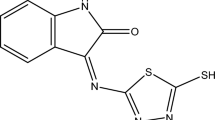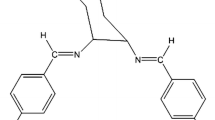Abstract
The inhibitive effect of a novel Schiff base can be evaluated by electrochemical measurements at the temperature range of 300–330 K. The inhibition efficiency of the inhibitor increases with increasing its concentration but decreases with increasing temperature. The polarisation measurement reveals that the inhibitor acts as a mixed type inhibitor. The inhibitive action of the inhibitor is attributed to the adsorption of inhibitor onto the steel surfaces, and it obeys the Langmuir adsorption isotherm model.






Similar content being viewed by others
References
M. Yadav, D. Behera, U. Sharma, Nontoxic corrosion inhibitors for N80 steel in hydrochloric acid. Chem. Sin. 3, 262–268 (2012)
P. Dohare, M.A. Quraishi, I.B. Obot, A combined electrochemical and theoretical study of pyridine-based Schiff bases as novel corrosion inhibitors for mild steel in hydrochloric acid medium. J. Chem. Sci. 130, 8 (2018). (in English)
Q.B. Zhang, Y.X. Hua, Carbon steel corrosion behavior in aqueous carbonated solution of MEA/[bmim] [DCA]. Electrochim. Acta 54, 1881–1887 (2009)
A.K. Singh, S. Thakur, B. Pani, G. Singh, Green synthesis and corrosion inhibition study of 2-amino-: N′-((thiophen-2-yl)methylene)benzohydrazide. New J. Chem. 42, 2113–2124 (2018). https://doi.org/10.1039/c7nj04162d
R. Yıldız, Adsorption and inhibition effect of 2, 4-diamino-6-hydroxypyrimidine for mild steel corrosion in HCl medium: experimental and theoretical investigation. Ionics 25, 859–870 (2019). https://doi.org/10.1007/s11581-018-2649-5
H. Zhanghuan, X. Pang, K. Gao, Localized CO2 corrosion of carbon steel with different microstructures in brine solutions with an imidazoline-based inhibitor. Appl Surf Sci 442, 446–460 (2018). https://doi.org/10.1016/j.apsusc.2018.02.115
E.S. Ferreira, C. Giancomlli, F.C. Giacomlli, A. Spinelli, Evaluation of the inhibitor effect of L-ascorbic acid on the corrosion of mild steel. Mater. Chem. Phys. 83, 129–134 (2004)
F. Bentiss, M. Lebrini, H. Vezin, F. Chai, M. Traisnel, M. Lagrenee, Enhanced corrosion resistance of carbon steel in normal sulfuric acid medium by some macrocyclic polyether compounds containing a 1,3,4-thiadiazole moiety: AC impedance and computational studies. Corros. Sci. 51, 2165–2173 (2009)
B.M. Prasanna, B.M. Praveen, N. Hebbar, T.V. Venkatesha, H.C. Tandon, Inhibition study of mild steel corrosion in 1 M hydrochloric acid solution by 2-chloro 3-formyl quinoline. Int. J. Ind. Chem. (2015). https://doi.org/10.1007/s40090-015-0064-6
A.S. Fouda, H. Ibrahim, S. Rashwaan, A. El-Hossiany, R.M. Ahmed, Expired drug (pantoprazole sodium) as a corrosion inhibitor for high carbon steel in hydrochloric acid solution. Int. J. Electrochem. Sci. 13, 6327–6346 (2018). (in English)
B.M. Prasanna, B.M. Praveen, N. Hebbar, M.K. Pavithra, T.S. Manjunatha, R.S. Malladi, Theoretical and experimental approach of inhibition effect by sulfamethoxazole on mild steel corrosion in 1-M HCl. Surf. Interface Anal. 50, 779–789 (2018). (in English)
N. Hebbar, B.M. Praveen, B.M. Prasanna, H.P. Sachin, Anticorrosion potential of flectofenine on mild steel in hydrochloric acid media: experimental and theoretical study. J. Fail. Anal. Prev. 18, 371–381 (2018). (in English)
P.B. Matad, P.B. Mokshanatha, N. Hebbar, V. Venkatesha, H.C. Tandon, Ketosulfone drug as a green corrosion inhibitor for mild steel in acidic medium. Ind. Eng. Chem. Res. 53, 8436–8444 (2014)
A. Shokri, F. Rabiee, K. Mahanpoor, Employing a novel nanocatalyst (Mn/Iranian hematite) for oxidation of SO2 pollutant in aqueous environment. Int. J. Environ. Sci. Technol. 14, 2485–2494 (2017)
Acknowledgments
The authors are grateful to the authorities of S. J. B Institute of Technology, Bangalore, India for providing lab facilities. Authors are also thankful to Vision Group on Science and Technology, Govt of Karnataka, for providing financial assistance under Centres of Innovative Science and Engineering Education (CISEE) scheme (Ref. no. GRD 532 dated 21/12/2017).
Author information
Authors and Affiliations
Corresponding author
Additional information
Publisher's Note
Springer Nature remains neutral with regard to jurisdictional claims in published maps and institutional affiliations.
Rights and permissions
About this article
Cite this article
Banuprakash, G., Prasanna, B.M., Hebbar, N. et al. Inhibitive Capability of a Novel Schiff Base for Steel in 1 M HCl Media. J Fail. Anal. and Preven. 20, 572–579 (2020). https://doi.org/10.1007/s11668-020-00865-2
Received:
Revised:
Published:
Issue Date:
DOI: https://doi.org/10.1007/s11668-020-00865-2




